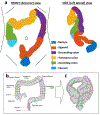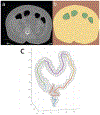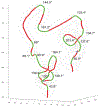The adult large bowel: describing environment morphology for effective biomedical device development
- PMID: 39655842
- PMCID: PMC11632178
- DOI: 10.1088/2516-1091/ad6dbf
The adult large bowel: describing environment morphology for effective biomedical device development
Abstract
An understanding of the biological environment, and in particular the physical morphology, is crucial for those developing medical devices and software applications. It not only informs appropriate design inputs, but provides the opportunity to evaluate outputs via virtual or synthetic models before investing in costly clinical investigations. The large bowel is a pertinent example, having a major demand for effective technological solutions to clinical unmet needs. Despite numerous efforts in this area, there remains a paucity of accurate and reliable data in literature. This work reviews what is available, including both processed datasets and raw medical images, before providing a comprehensive quantitative description of the environment for biomedical engineers in this and related regions of the body. Computed tomography images from 75 patients, and a blend of different mathematical and computational methods, are used to calculate and define several crucial metrics, including: a typical adult size (abdominal girth) and abdominal shape, location (or depth) of the bowel inside the abdomen, large bowel length, lumen diameter, flexure number and characteristics, volume and anatomical tortuosity. These metrics are reviewed and defined by both gender and body posture, as well as-wherever possible-being spilt into the various anatomical regions of the large bowel. The resulting data can be used to describe a realistic 'average' adult large bowel environment and so drive both design specifications and high fidelity test environments.
Keywords: colon specifications; endoscopy; large bowel; medical image analysis; morphology; virtual anatomy.
Creative Commons Attribution license.
Conflict of interest statement
Conflict of Interest
The authors have no conflicts to disclose.
Figures









References
Publication types
MeSH terms
Grants and funding
LinkOut - more resources
Full Text Sources
